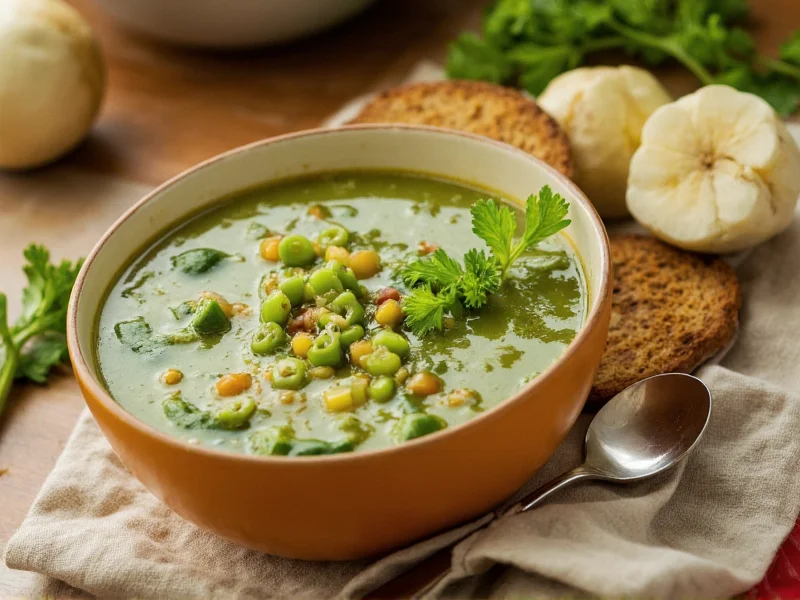The Cultural Roots of Okra Soup
Okra soup traces its origins to West Africa, where it has been a staple for centuries. Known as draw soup in Nigeria and gumbo in Louisiana Creole cuisine, this versatile dish traveled across continents through the transatlantic slave trade. Traditional West African versions often incorporate palm oil, smoked fish, and leafy greens, while Caribbean adaptations feature coconut milk and Scotch bonnet peppers. Understanding these cultural foundations helps appreciate okra soup's significance beyond mere sustenance—it represents culinary heritage and adaptation.
Nutritional Profile and Health Benefits
Okra soup delivers impressive nutritional value per serving. A single cup provides approximately 30 calories, 3 grams of dietary fiber, and significant amounts of vitamins K, C, and A. The soluble fiber in okra helps regulate blood sugar levels, making it beneficial for diabetes management. Additionally, okra's mucilage content supports digestive health by acting as a prebiotic that nourishes beneficial gut bacteria. Regular consumption of okra soup may contribute to heart health through its potassium content, which helps maintain healthy blood pressure levels.
Mastering Okra Preparation Techniques
Many home cooks struggle with okra's natural sliminess, but proper preparation techniques can significantly reduce this characteristic. For traditional okra soup preparation, try these effective methods:
- Cook okra pods whole to minimize mucilage release
- Add acidic ingredients like tomatoes or lemon juice early in cooking
- Dry-roast okra in the oven at 350°F for 15 minutes before adding to soup
- Cut okra just before cooking rather than in advance
- Use cast iron pots which help reduce sliminess through chemical reactions
| Preparation Method | Effectiveness Rating | Best For |
|---|---|---|
| Dry roasting before cooking | ★★★★☆ | Traditional West African soups|
| Adding tomatoes early | ★★★★★ | Most soup variations|
| Cooking whole pods | ★★★☆☆ | Gumbo and thick soups|
| Using cast iron cookware | ★★★☆☆ | Authentic regional preparations
Authentic Okra Soup Recipe
Creating a flavorful okra soup requires attention to ingredient quality and cooking sequence. For a traditional West African-inspired okra soup recipe, gather these ingredients:
- 500g fresh okra pods, washed and trimmed
- 2 cups chicken or vegetable broth
- 1 cup diced tomatoes
- 1 medium onion, finely chopped
- 2 cloves garlic, minced
- 1 teaspoon smoked paprika
- 1/2 teaspoon cayenne pepper (optional)
- 2 tablespoons palm oil or olive oil
- Salt to taste
- Protein of choice: shrimp, chicken, or smoked fish
Step-by-Step Preparation
- Dry roast okra pods in oven at 350°F for 15 minutes to reduce sliminess
- Heat oil in heavy-bottomed pot and sauté onions until translucent
- Add garlic, tomatoes, and spices; cook for 5 minutes until tomatoes break down
- Pour in broth and bring to gentle simmer
- Add roasted okra pods and protein; simmer uncovered for 20-25 minutes
- Season with salt and adjust spices to taste
- Serve hot with fufu, rice, or crusty bread
Regional Variations Worth Exploring
Okra soup adapts beautifully to local ingredients and preferences. The Nigerian version often includes bitterleaf and ugwu (fluted pumpkin leaves), while Senegalese okra soup features fish and broken rice. In the American South, okra soup evolved into gumbo with the addition of the "holy trinity" (onions, celery, and bell peppers) and a dark roux. For vegetarians, a Mediterranean-inspired okra soup with chickpeas and lemon offers a refreshing alternative. Each variation maintains okra's distinctive texture while showcasing regional flavors.
Serving and Storage Recommendations
For optimal flavor development, allow okra soup to rest for at least 30 minutes before serving. This resting period allows flavors to meld and the soup to thicken slightly. Traditional accompaniments include fufu (pounded yam), rice, or crusty bread for dipping. When storing leftovers, keep in an airtight container in the refrigerator for up to 4 days or freeze for up to 3 months. Reheat gently on the stove, adding a splash of broth if the soup has thickened too much during storage. The soup often tastes even better the next day as flavors continue to develop.











 浙公网安备
33010002000092号
浙公网安备
33010002000092号 浙B2-20120091-4
浙B2-20120091-4